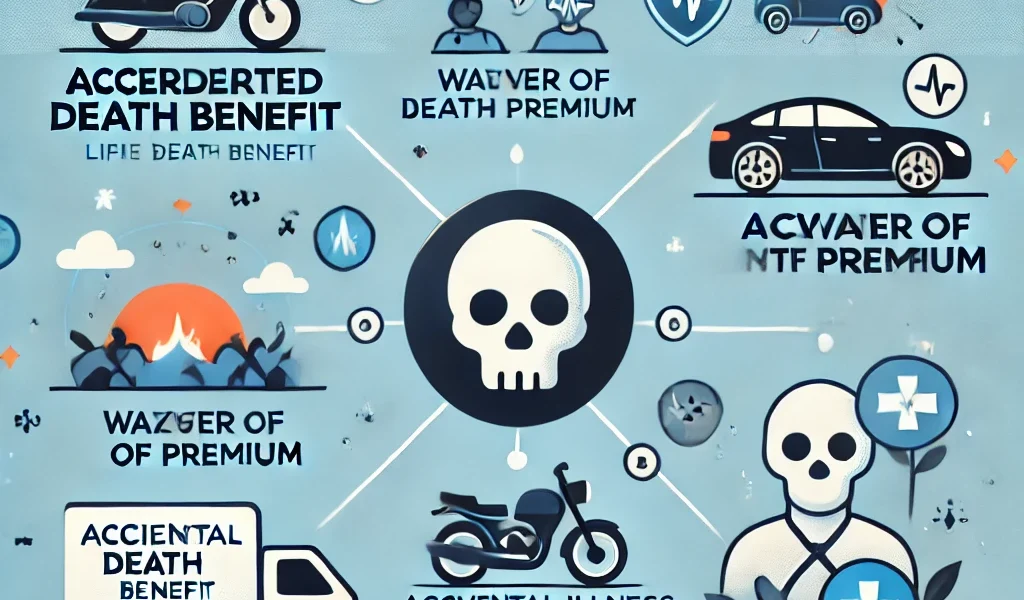Introduction
Life insurance is a powerful financial tool that protects your loved ones in case of an unfortunate event. However, did you know that you can enhance your policy with life insurance riders? Riders are optional add-ons that provide extra coverage and benefits, tailoring your policy to your specific needs.
Many people overlook these valuable add-ons, assuming they’re unnecessary or too expensive. But in reality, the right riders can significantly increase the value of your life insurance policy without breaking the bank.
This DIY guide will break down what life insurance riders are, the most common types available, and how to determine which ones best suit your needs. By the end, you’ll have a clear understanding of how to maximize your policy’s benefits.
1. What Are Life Insurance Riders?
A life insurance rider is an additional provision added to your standard policy that provides extra coverage or benefits beyond the basic death benefit. Riders allow policyholders to customize their insurance plans according to their personal and financial needs.
Some riders come at no additional cost, while others require a small increase in premium. These add-ons can provide living benefits, enhance payouts, or waive premiums under certain conditions.
2. Why Should You Consider Life Insurance Riders?
Adding riders to your life insurance policy can be a smart financial move. Here’s why:
✔ Enhanced Protection – Riders provide additional security beyond the standard policy. ✔ Financial Flexibility – Some riders allow early access to benefits during critical situations. ✔ Cost Efficiency – Instead of buying separate policies, riders can provide extra coverage at a lower cost. ✔ Peace of Mind – Customizing your policy ensures your loved ones receive the most comprehensive support possible.
Now, let’s explore some of the most valuable riders available.
3. Common Types of Life Insurance Riders
a) Accelerated Death Benefit Rider (Must-Have for Terminal Illness Protection)
- Allows you to access a portion of your death benefit early if diagnosed with a terminal illness.
- Helps cover medical expenses, debt, or other financial burdens.
- Typically included at no extra cost by many insurers.
b) Waiver of Premium Rider (Best for Income Protection)
- Waives premium payments if you become disabled or unable to work due to an illness or accident.
- Ensures your policy remains active even if you can’t afford to pay.
- Highly recommended for self-employed individuals and sole breadwinners.
c) Critical Illness Rider (Best for Serious Health Conditions)
- Provides a lump sum payout if diagnosed with life-threatening illnesses like cancer, heart attack, or stroke.
- Helps cover expensive treatments and recovery costs.
- A valuable option for those with a family history of critical illnesses.
d) Accidental Death Benefit Rider (Extra Security for Unexpected Events)
- Pays an additional sum (often double the policy’s death benefit) if death occurs due to an accident.
- Ideal for individuals with high-risk occupations or frequent travelers.
- Low-cost rider that significantly increases coverage.
e) Long-Term Care (LTC) Rider (Best for Future Healthcare Needs)
- Helps cover nursing home or home healthcare costs if you develop a chronic illness or disability.
- Protects your savings from being drained by long-term medical expenses.
- A must-have for those planning for retirement and aging-related care.
f) Child or Spouse Rider (Affordable Family Coverage)
- Provides limited life insurance coverage for your spouse or children.
- Helps cover funeral expenses or medical costs in case of an unfortunate event.
- Can often be converted into a separate permanent policy for your child in the future.
g) Return of Premium Rider (Best for Refund Seekers)
- Refunds all the premiums paid if you outlive your policy’s term.
- Offers a way to recoup your investment while ensuring coverage.
- Higher cost but beneficial for those who want life insurance without feeling like they “wasted” money.
4. How to Choose the Right Life Insurance Riders
With so many options available, how do you decide which riders are worth adding to your policy? Here are some key factors to consider:
🔹 Assess Your Needs: Do you have dependents? A mortgage? Any health concerns? Consider what financial risks you need to cover. 🔹 Evaluate Costs: Some riders are free, while others increase your premium. Weigh the costs versus the benefits. 🔹 Think Long-Term: Choose riders that will benefit you not just today, but in the future (e.g., long-term care or waiver of premium). 🔹 Compare Insurers: Different companies offer different riders. Shop around to find the best options at competitive rates. 🔹 Consult an Expert: If unsure, consult with a financial advisor or insurance agent to determine the best fit for your situation.
5. Pros & Cons of Adding Life Insurance Riders
| Pros | Cons |
|---|---|
| Provides extra financial protection | Increases premium costs |
| Customizes policy to fit your needs | Not all riders are available with every insurer |
| Some riders offer living benefits | May require medical exams for eligibility |
| Can prevent financial hardship | Some riders have usage restrictions |
6. How to Add Riders to Your Policy
Adding riders is a straightforward process:
✔ Step 1: Choose a base life insurance policy (term or whole life). ✔ Step 2: Review available riders with your insurance provider. ✔ Step 3: Select riders that align with your financial and personal needs. ✔ Step 4: Understand the terms and conditions (e.g., waiting periods, exclusions). ✔ Step 5: Complete paperwork and medical exams (if required). ✔ Step 6: Keep your beneficiaries informed about your policy and added riders.
Conclusion: Are Life Insurance Riders Worth It?
Life insurance riders are powerful tools that can enhance your coverage and provide valuable financial benefits. While not everyone needs every rider, carefully selecting the right ones can add tremendous value to your policy.
If you’re unsure about which riders to add, take the time to assess your needs and consult with an insurance expert. A well-chosen rider could mean the difference between a basic life insurance plan and a comprehensive safety net for you and your loved ones.




